Slipping Clutch? Quick Fixes and When to Call a Pro
First thing’s first – a slipping clutch feels like the engine revs but the car won’t speed up. If you’ve ever noticed that strange lag when you push the gas, you’re probably dealing with a slipping clutch. It’s a common issue for manual drivers and can range from a minor annoyance to a serious safety risk.
What Causes a Clutch to Slip?
The clutch works by pressing friction material against the flywheel. Over time that material wears down, gets oily, or the pressure plate loses strength. Heavy launching, riding the clutch, or sudden temperature spikes can speed up wear. In many cases, a burned‑smell, a high‑pitched squeal, or a jerky feel points straight to the clutch.
Quick DIY Checks Before Visiting the Garage
Grab a friend and try the hill‑hold test. Find a low incline, press the clutch in, shift to first, and release the pedal slowly. If the engine revs but the car rolls back, the clutch is slipping. Next, look under the car for oil leaks around the bell housing – oil can contaminate the friction surface and cause slip.
If the clutch feels spongy or you need to press the pedal all the way down, the hydraulic system might be low on fluid or have a leak. Check the master‑cylinder reservoir and top it up if needed. A simple bleed can sometimes restore proper pressure.
These checks help you decide whether a quick adjustment will do or if the clutch needs a full replacement. Keep in mind that a slipping clutch often means the friction plates are worn thin – a short‑term fix won’t last long.
When you head to a shop, be clear about the symptoms: “My engine revs but the car doesn’t accelerate, especially on hills.” The mechanic will likely inspect the clutch disc, pressure plate, and flywheel. If you need an estimate, a typical clutch replacement runs between £400‑£800, depending on parts and labor. Some garages offer a “stage 2 clutch kit” for extra performance, but that’s an upgrade, not a fix for slip.
Do you want to extend a new clutch’s life? Avoid riding the clutch pedal, shift quickly, and don’t launch the car from a standstill with high revs. Regularly check your fluid, and keep the clutch clean from oil or grease.
If you’re comfortable with tools, you can replace the clutch yourself, but it’s a big job – you’ll need a transmission jack, a torque wrench, and the right service manual. For most drivers, letting a professional handle the removal and installation saves time and avoids costly mistakes.
Bottom line: a slipping clutch signals wear or contamination. Simple tests can tell you if it’s a quick fix or a full replacement. When in doubt, trust a qualified garage to give you a clear quote and get you back on the road safely.
 26 June 2025
26 June 2025
How to Fix a Slipping Clutch Without Replacement: Proven Tips and DIY Solutions
Learn proven techniques to fix a slipping clutch without replacing it. Get DIY tips, real solutions, and interesting facts to save money and drive smoothly.






0